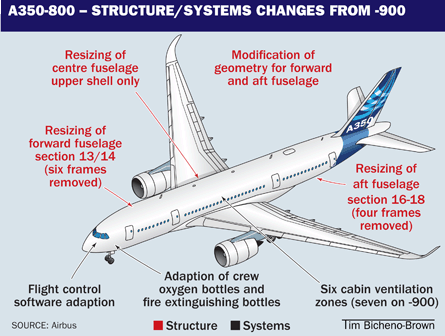Airbus is about to begin the detailed design effort of the next XWB iteration, the A350-800 shrink, in parallel with its efforts to begin the industrial ramp-up for the initial -900 variant.
The second member of the A350 family is due to enter service in the third quarter of 2014, around a year after the baseline -900. A stretched variant, the -1000, will follow at the end of 2015. Launch customer for all three variants is Qatar Airways.
The -800's concept was revamped in 2009 to be developed as a simple shrink of the -900, incorporating minor changes to the systems and structure, rather than as an optimised variant.
"We had been planning to optimise the -800 design a lot for its lower take-off weight with a different structure, landing gear and so on," says A350 chief engineer Gordon McConnell. "We were chasing economics to provide the lightest possible aircraft."
However, McConnell says that there was pressure from airlines to rethink this plan because of commonality concerns and the wish for additional range - the original A350-800 was designed to fly around 15,360km (8,300nm).
 |
|---|
"The airlines said that the optimisation wasn't good for their cost of ownership if they operated both -800 and -900 variants. Some airlines also asked if we could use the -900's structural capability to give the -800 more range. Industrially, it also wasn't very good for us to optimise it."
Airbus is going forward with the revamped -800 plan, based around the -900, having reached the design freeze late last year. "We've issued the design loads for the -800 and we'll start the detailed design this year with improved payload/range performance," says McConnell.
The new -800 has a common wing with the -900 in terms of size, configuration and high-lift devices, while much of the structure is also identical. The A350-1000, now being defined, will have a wing around 4% bigger than the -800/900's, through a trailing-edge extension.
The -800's fuselage is shortened by 10 frames (six forward and four aft), which McConnell says requires changes to the geometry of section 13/14 (forward), section 16/18 (rear) and the upper shell of section 15 (centre fuselage).
"We're only changing systems where we need to because we're shortening the fuselage - for example there'll be some adaptation of the flight-control software because the aircraft will handle slightly differently."
McConnell says some equipment has been altered and relocated as a result of the fuselage being shorter, specifically the crew and fire-extinguishing oxygen bottles.
"The basic weights of the -800 are unchanged [the 248t maximum take-off weight, for example], but we have increased weights available as an option," says McConnell.
An optional 11t increase in MTOW, to 259t, gives up to 460km more range than the old -800 variant. "We have two max zero fuel/max landing weights, which allows us to offer 3t more payload capability as an option," McConnell says.
The -800 engine will be common to the 84,000lb-thrust (374kN) Rolls-Royce Trent XWB that powers the -900, but offered at various deratings as a result of its lower operating weights.
The basic 248t MTOW -800 will be offered with a 75,000lb sea level thrust rating, while the 279t MTOW option will have 79,000lb thrust. "We'll also offer a 'hot and high' rating option flat-rated at 79,000lb at higher altitudes and temperatures which uses the full capability of the -900's 84,000lb-thrust engine," says McConnell. "Typically this might be used by someone operating to Mexico City, for example."
The A350-900 is due to fly in mid-2012 - three months later than previously planned due to a hold-up in the completion of some of the structural design. Airbus does not expect this to impact the delivery schedule or the development timetable of the other variants.
Source: Flight International























